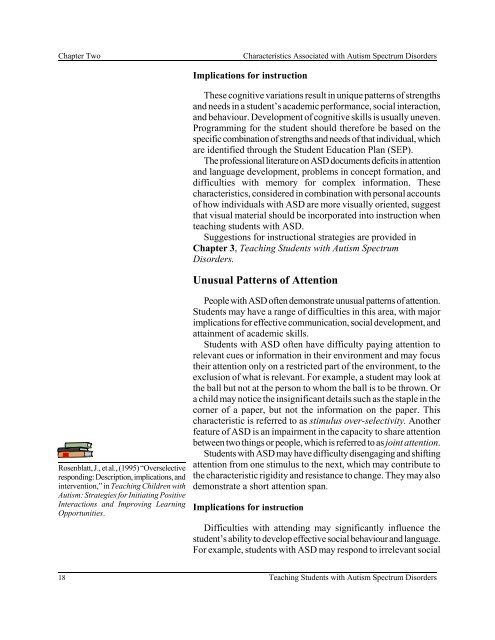Teaching Students with Autism Spectrum Disorders
Teaching Students with Autism Spectrum Disorders
Teaching Students with Autism Spectrum Disorders
You also want an ePaper? Increase the reach of your titles
YUMPU automatically turns print PDFs into web optimized ePapers that Google loves.
Chapter Two Characteristics Associated <strong>with</strong> <strong>Autism</strong> <strong>Spectrum</strong> <strong>Disorders</strong><br />
Rosenblatt, J., et al., (1995) “Overselective<br />
responding: Description, implications, and<br />
intervention,” in <strong>Teaching</strong> Children <strong>with</strong><br />
<strong>Autism</strong>: Strategies for Initiating Positive<br />
Interactions and Improving Learning<br />
Opportunities.<br />
Implications for instruction<br />
These cognitive variations result in unique patterns of strengths<br />
and needs in a student’s academic performance, social interaction,<br />
and behaviour. Development of cognitive skills is usually uneven.<br />
Programming for the student should therefore be based on the<br />
specific combination of strengths and needs of that individual, which<br />
are identified through the Student Education Plan (SEP).<br />
The professional literature on ASD documents deficits in attention<br />
and language development, problems in concept formation, and<br />
difficulties <strong>with</strong> memory for complex information. These<br />
characteristics, considered in combination <strong>with</strong> personal accounts<br />
of how individuals <strong>with</strong> ASD are more visually oriented, suggest<br />
that visual material should be incorporated into instruction when<br />
teaching students <strong>with</strong> ASD.<br />
Suggestions for instructional strategies are provided in<br />
Chapter 3, <strong>Teaching</strong> <strong>Students</strong> <strong>with</strong> <strong>Autism</strong> <strong>Spectrum</strong><br />
<strong>Disorders</strong>.<br />
Unusual Patterns of Attention<br />
People <strong>with</strong> ASD often demonstrate unusual patterns of attention.<br />
<strong>Students</strong> may have a range of difficulties in this area, <strong>with</strong> major<br />
implications for effective communication, social development, and<br />
attainment of academic skills.<br />
<strong>Students</strong> <strong>with</strong> ASD often have difficulty paying attention to<br />
relevant cues or information in their environment and may focus<br />
their attention only on a restricted part of the environment, to the<br />
exclusion of what is relevant. For example, a student may look at<br />
the ball but not at the person to whom the ball is to be thrown. Or<br />
a child may notice the insignificant details such as the staple in the<br />
corner of a paper, but not the information on the paper. This<br />
characteristic is referred to as stimulus over-selectivity. Another<br />
feature of ASD is an impairment in the capacity to share attention<br />
between two things or people, which is referred to as joint attention.<br />
<strong>Students</strong> <strong>with</strong> ASD may have difficulty disengaging and shifting<br />
attention from one stimulus to the next, which may contribute to<br />
the characteristic rigidity and resistance to change. They may also<br />
demonstrate a short attention span.<br />
Implications for instruction<br />
Difficulties <strong>with</strong> attending may significantly influence the<br />
student’s ability to develop effective social behaviour and language.<br />
For example, students <strong>with</strong> ASD may respond to irrelevant social<br />
18 <strong>Teaching</strong> <strong>Students</strong> <strong>with</strong> <strong>Autism</strong> <strong>Spectrum</strong> <strong>Disorders</strong>

















